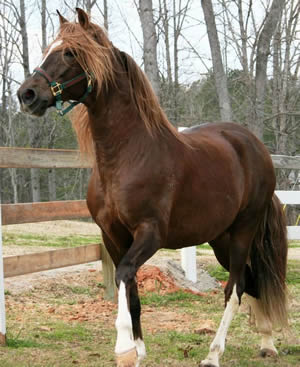General Description
Physically, the Paso is a horse of medium size, usually standing between 14.1 and 15.2 hands tall, with a powerful build. He may be chestnut, black, brown, bay, buckskin, palomino, gray, roan or dun; with the solid colors, grays and dark skin considered most desirable. The mane is abundant with fine, lustrous hair that may be curly or straight. Horses must be shown unshod.
The Peruvian Paso horse should have an appearance of energy, grace and refinement. Horses should have a well-developed muscular appearance without exaggerations. The head is of medium size with a straight or slightly concave profile; a small muzzle; oblong nostrils which extend easily; dark skin; dark expressive eyes set well apart; moderately marked jowls and medium length ears with fine tips curved slightly inward. The neck is of medium length with a graceful arch to the crest. It is slightly heavier in proportion to the body than with most light saddle breeds. The back is medium to short in length, strong and rounded. Loins broad and well muscled over kidney area. Croup long and wide, fairly muscular with moderate slope and nicely rounded. Tail is set low and viewed from the rear is carried straight, quietly and held close to the buttocks. Chest is wide with abundant muscling. Rib cage well sprung and deep. The barrel is deep and the underline is nearly level from the last rib to the brisket. Flanks are moderately short, full and deep. Quarters should be strong, of medium roundness and width. Shoulders long, very well inclined and well muscled, especially at the withers. Bones of the lower limbs should be well aligned and well articulated so that the long bones line up with each other correctly above and below the joints with the skin tight against the bone and strong, prominent tendons.
Pasterns of medium length and springy but not showing weakness. Cannon bones are short. Slightly more angle to the hock than other light saddle breeds.
Today, the Peruvian Paso transmits its smooth gait to all purebred foals. No artificial devices or special training aids are necessary to enable the horse to perform its specialty - a natural four-beat footfall of medium speed that provides a ride of incomparable smoothness and harmony of movement. In addition to an easy gait, the Peruvian Paso's creators desired their new breed to retain brilliant action typified by lift as the knee and fetlock flex, combined with "termino," a movement of the front legs similar to the loose outward rolling of a swimmer's arms in the crawl.
Gaits
(a) Paso llano: Equally spaced, four beat gait. Timing and footfall: 1 - 2 - 3 - 4; LH - LF - RH - RF
(b) Sobreandando: Usually faster, slightly more lateral than the Paso llano. Timing and footfall: 1,2 - 3,4; LH, LF - RH,RF.






